I mentioned earlier in these pages that in over 60 years of riding, one policy has never failed me—I always take time to greet my horse and help him feel safe and comfortable before I get on. That means the horse makes eye contact, willingly nose bumps me, and wants me to touch him. If he does not want to make eye contact or acknowledge you on the ground, then you certainly are not going to have a safe ride on top. Many of the under-saddle behavioral issues we see are because the horse does not feel safe with the rider. No amount of restraining devices will make the horse feel safe. Always check for stress-related behaviors before getting on. Stressed and worried horses are usually unpredictable horses.
Many stress-related behaviors start with restricting horses who do not need restriction.
We’ve already talked about how stress can be reduced with a well-fitting bit and noseband—if they are even necessary for your horse. There are more mouth-and-head restrictive devices for the horse than a person can count. But I ask, how can it be that a horse learns to work cows with limited control of his mouth and face, while a jumper and dressage horse seem to need a plethora of bits, tight nosebands, and leverage devices? Is it because history and culture dictate differences rather than what is needed to communicate with the horse and rider? “Horse training” has come a long way from the abusive methods once practiced, but there is still a long way to go in implementing “horse-centric” thinking in training and management, rather than “human-centric.” The irony is that there are much safer and quicker ways to get horses to do the things we want them to do when we take the time to understand the basics of how horses think, feel, and behave. I hope in these pages you gain the tools and knowledge you need to feel comfortable going outside the box of your discipline and using appropriate science to improve your relationship and performance with your horse.

Gabriel checks the saddle fit and watches his mare Cassie’s eye as he tightens the girth—it shows her worry. After a moment, she relaxes, which you can also see in her eye.
As most would agree, there is nothing “natural” about the horse having a human predator on his back. But because of horses’ gentle nature and willingness to work with humans, they tolerate, and in many cases seem to enjoy, interaction with humans. Horses want friendly people who will protect them at all times. Building a trusting relationship on the ground and then transferring this relationship to the horse’s back is the best way to form a strong, trusting bond and create a general sense of safety for your horse.
TIP: / Horses need to have the freedom to communicate and move comfortably when ridden. /
Clearly, researchers need to address a number of variables when it comes to causes of stress in the ridden horse, including the effect of various riders, the horse’s level of training, the horse’s temperament and mood, and his physical conformation and ability to perform the tasks asked of him. Take a good look at the tack and training methods you see in use at your barn and at showgrounds, and consider for yourself which methods are least stressful for horses. A few studies designed to measure horse learning and stress actually showed that the action of learning itself was not as stressful as the interaction with the person riding. This indicates, again, that the relationship the horse and rider have together is the key (fig. 12.28).
Talk to your horse. He may not understand your words, but he will understand the tone of your voice and soothing energy.
Guidelines for Minimizing Stress While Riding
- Friendly Greeting Before getting on, greet your horse. Horses greet each other every time they are gone or out of each other’s sight for even a few minutes. Following equine protocol, always say hello to your horse to see what kind of mood he is in before you ride. And never get on a horse you do not know before establishing a friendly relationship with: soft eye contact while smiling, blinking, and talking; gentle touch of the back of your hand to the horse’s nose; and a friendly touch or scratch on the withers or neck.
- Physical Comfort Before you get on, get your hands on your horse and do a general body check for soreness, tightness, and sensitive areas (see p. 194). Oftentimes horses will be girthy and not like to be brushed if they have ulcers or “stuck” ribs. Make sure your tack fits comfortably (fig. 12.29). Once in the saddle, continuously check for your horse’s comfort in the training. If he resists doing something, it usually is because he does not understand, he physically cannot do it, or he is worried about something hurting. Horses who spook or run off suddenly with no apparent trigger may have felt a sudden pinched sciatic nerve or an ulcer pain. It is critical to not discipline your horse in these situations but rather check his eye and facial expression to see what he is feeling and thinking. The horse who is “testing” you with his behavior will have a completely different expression than the horse in pain or worry.
- Feeling of Safety Help your horse feel safe with you by talking to him about what he is going to experience and what you would like him to do. When we speak out loud, we visualize, and horses can then interpret our thoughts and feelings. Be just as much or more aware of your surroundings with your horse’s safety in mind than your horse is. Be “horse-centric” in your thinking and feeling. Always give your horse time to:
— Adjust to new objects and situations. Take time to listen to your horse and coach him through his concerns. Be firm, relaxed, confident, and kind.
— Adjust to changes in light. Remember, it takes at least 15 minutes for your horse’s eyes to recalibrate when going from dark to light or light to dark.
— Warm up and re-establish proprioception. He needs to know where his body is in relationship to the environment, others horses, and objects. Often horses who are usually ridden alone will spook when another horse comes toward them in a ring, as the horse has no proprioceptive references for safety around others. - Connection and Communication Using soft hands and seat, feel and connect with your horse so he knows you are there for him. Remember to be his eyes, ears, nose, and body—as long as you are on your horse’s back, you are responsible for his safety. Be as light and sensitive as possible in your communication with your horse, making sure to:
— Stay focused with your horse. If you are distracted, then your horse may be, too.
— Stay connected through your voice and regular physical touches on the withers or neck.
— Keep an open dialogue, listening to what your horse needs, not just telling him what you want. Look for constant feedback.
***
Order your copy of A Horse By Nature from Trafalgar Square Books here.

